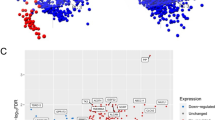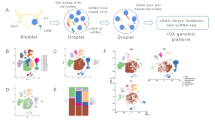Abstract
Purpose
Bladder carcinoma is the most common urological malignancy in China. Gene mutation may be one of causes of carcinogenesis in the cancer. We therefore investigated the mRNA expression of RTKN gene in clinic malignant bladder carcinoma and explored the relationship between the novel gene and the cancer.
Methods
Total RNA was extracted from 33 surgically resected specimens of bladder carcinoma and 19 specimens of tumor-free bladder tissues. After the optimal reverse-transcription polymerase chain reaction condition was established, the mRNA expression levels of the RTKN gene in the lesions and tumor-free bladder tissues were examined semiquantitatively, and the relationships between expression levels of RTKN and clinical pathological features were analyzed.
Results
The expression of RTKN gene mRNA in 33 human bladder carcinoma tissues was significantly higher than that in 19 human tumor-free bladder tissues (0.937±0.103 vs. 0.350±0.082). The average ratio of RTKN expression in neoplasms to that in tumor-free bladder tissues was 0.350±0.164. Based on this ratio the 33 patients were divided into three groups: a downregulated expression group (n=2), an upregulated expression group (n=22), and an unchanged group (n=9). Although the χ2 test demonstrated a statistically nonsignificant differences in RTKN expression between tumor stages Ta, T1, and T2 overall in the 33 human bladder carcinoma, the t test showed that there were statistically significant differences between solitary and multiple tumors, between the paired group aged younger or older than 70 years in 27 de novo bladder carcinoma patients, and between the groups with tumor larger or smaller than 2.25 cm3.
Conclusions
These results suggest that the RTKN gene is involved in bladder carcinogenesis and progression in bladder carcinoma, indicating that RTKN gene could be a molecular target in cancer therapy.


Similar content being viewed by others
References
Chen J, Yu L, Li D, Gao Q, Wang JS, Huang XH, Bi G, Wu H, Zhao SY (2003) Human, a novel enzyme-crystallin overoverexpressed in liver and kidney and downregulated in 58% of liver cancer tissues from Chinese patients, and four new homologs from other mammalians. Gene 302:103–113
Fritz G, Brachetti C, Bahlmann F, Schmidt M, Kaina B (2002) Rho GTPases in human breast tumours: expression and mutation analyses and correlation with clinical parameters. Br J Cancer 87:635–644
Fu Q, Yu L, Liu Q, Zhang J, Zhang H, Zhao S (2000) Molecular cloning, expression characterization, and mapping of a novel putative inhibitor of rho GTPase activity, RTKN, to D2S145-D2S286. Genomics 66:328–332
Fujiisawa K, Madaule P, Ishizaki T, Watanabe G, Bito H, Saito Y, Hall A,, Narumiya S (1998) Different regions of Rho determine Rho-selective binding of different classes of Rho target molecules. J Biol Chem 273:18943–18949
Gussow D, Rein R, Ginjaar I, Hochstenbach F, Seemann G, Kottman A, Ploegh HL (1987) The human beta-2-microglobulin gene: primary structure and definition of the transcriptional unit. J Immunol 139:3132–3138
Horiuchi A, Imai T, Wang C, Ohira S, Feng Y, Nikaido T, Konishi I (2003) Up-regulation of small GTPases, RhoA and RhoC, is associated with tumor progression in ovarian carcinoma. Lab Invest 83:861–870
Jiang JM, Yu L, Huang XH, Chen X, Li D, Zhang YZ, Tang LS, Zhao SY (2001) Identification of two novel human dynein light chain genes, DNLC2A and DNLC2B, and their expression changes in hepatocellular carcinoma tissues from 68 Chinese patients. Gene 281:103–113
Kamai T, Arai K, Tsujii T, Honda M, Yoshida K (2001) Overexpression of RhoA mRNA is associated with advanced stage in testicular germ cell tumour. BJU Int 87:227–231
Kamai T, Arai K, Sumi S, Tsujii T, Honda M, Yamanishi T, Yoshida KI (2002) The rho/rho-kinase pathway is involved in the progression of testicular germ cell tumour. BJU Int 89:449–453
Kamai T, Tsujii T, Arai K, Takagi K, Asami H, Ito Y, Oshima H (2003) Significant association of Rho/ROCK pathway with invasion and metastasis of bladder cancer. Clin Cancer Res 9:2632–2641
Kleer CG, van Golen KL, Zhang Y, Wu ZF, Rubin MA, Merajver SD (2002) Characterization of RhoC expression in benign and malignant breast disease: a potential new marker for small breast carcinomas with metastatic ability. Am J Pathol 160:579–584
Narumiya S, Ishizaki T, Watanabe N (1997) Rho effectors and reorganization of actin cytoskeleton. FEBS Lett 410:68–72
Olson MF, Paterson HF, Marshal CJ (1998) Signals from Ras and Rho GTPases interact to regulate expression of P21waf/cip1. Nature 394:295–299
Ozaki I, Mizuta T, Zhao G, Yotsumoto H, Hara T, Kajihara S, Hisatomi A, Sakai T, Yamamoto K (2000) Involvement of the Ets-1 gene in overexpression of matrilysin in human hepatocellular carcinoma. Cancer Res 60:6519–6525
Przybojewska B, Jagiello A, Jalmuzna P (2000) H-RAS, K-RAS, and N-RAS gene activation in human bladder cancers. Cancer Genet Cytogenet 121:73–77
Reid D, furuyashiki T, Ishizakit T, Watanabe G, Watanabe N, Fujisawa K, Morii N, Madaule P, Narumiya S (1996) Rhotekoin, a new putative target for Rho bearing homology to a serine/threonine kinase, PTN, and rhophilin in the Rho-binding domain. J Biol Chem 271:13556–13560
Riddley AJ, Hall A (1994) Signal transduction pathways regaluting Rho-mediated stress fibre formation: requirement for a tyrosine kinase. EMBO J 13:2600–2610
Sakurada S, Okamoto H, Takuwa N, Sugimoto N, Takuwa Y (2001) Rho activation in excitatory agonist-stimulated vascular smooth muscle. Am J Cell Physiol 281:C571–C578
Seasholtz TM, Majumdar M, Kaplan DD, Brown JH (1999) Rho and Rho Kinase mediate thrombin-stimulated vascular smooth muscle cell DNA synhesis and migration. Circ Res 84:1186–1193
Seraj MJ, Harding MA, Gildea JJ, Welch DR, Theodorescu D (2000) The relationship of BRMS1 and RhoGDI2 gene expression to metastatic potential in lineage related human bladder cancer cell lines. Clin Exp Metastasis 18:519–525
Suwa H, Ohshio G, Imamura T, Watanabe G, Arii S, Imamura M, Narumiya S, Hiai H, Fukumoto M (1998) Overexpression of the rhoC gene correlates with progression of ductal adenocarcinoma of the pancreas. Br J Cancer 77:147–152
Van Aelst L, D’Souza-Schorey C (1997) Rho GTPases and signaling networks. Genes Dev 11:2295–2322
Yossepowitch O, Dalbagni G (2002) Transitional cell carcinoma of the bladder in young adults: presentation, natural history and outcome. J Urol 168:61–66
Author information
Authors and Affiliations
Corresponding author
Additional information
J. Fan and L.-J. Ma contributed equally to this manuscript
This work was supported by National Natural Science Foundation of China (no. 39900146)
Rights and permissions
About this article
Cite this article
Fan, J., Ma, LJ., Xia, SJ. et al. Association between clinical characteristics and expression abundance of RTKN gene in human bladder carcinoma tissues from Chinese patients. J Cancer Res Clin Oncol 131, 157–162 (2005). https://doi.org/10.1007/s00432-004-0638-8
Received:
Accepted:
Published:
Issue Date:
DOI: https://doi.org/10.1007/s00432-004-0638-8




